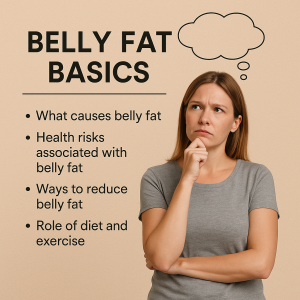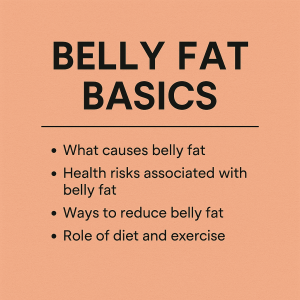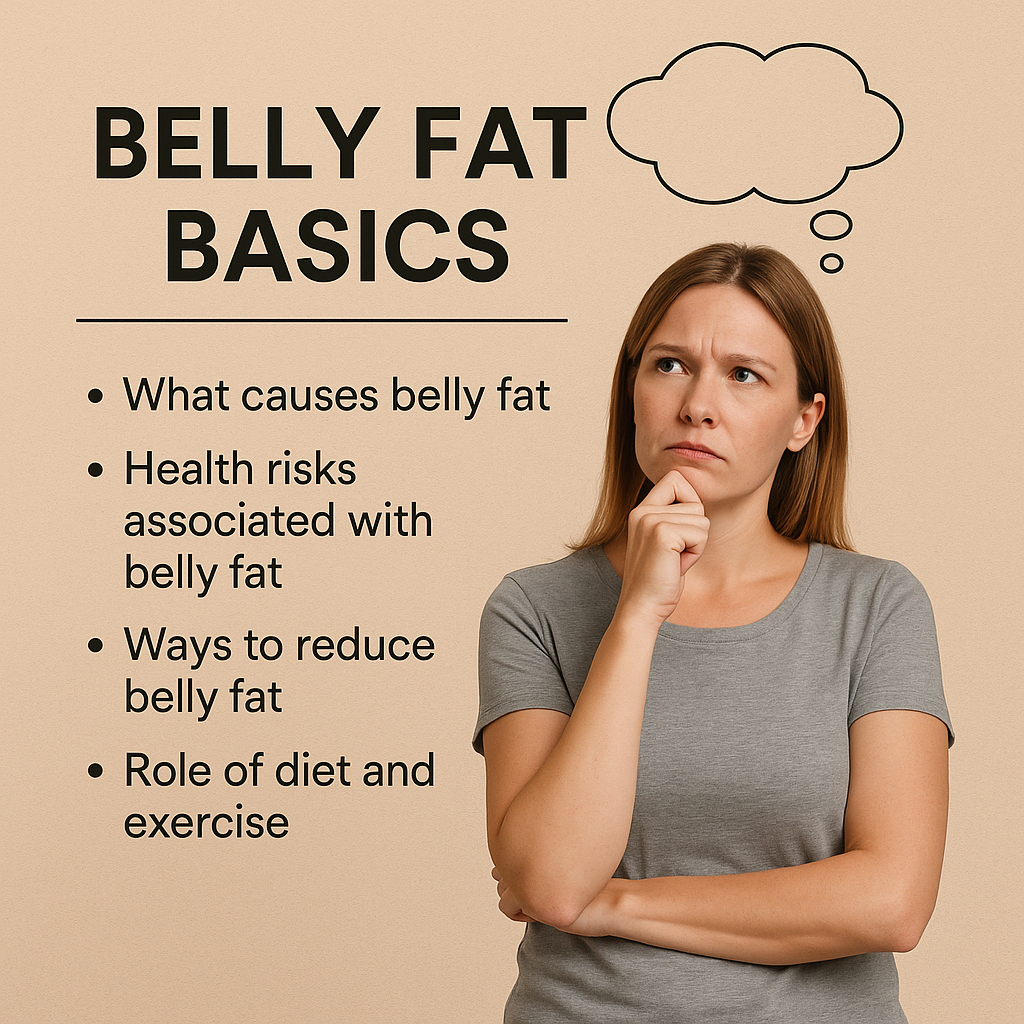Belly Fat Basics: Proven Insights & Smart Strategies for a Healthier You (2025 Edition)

Introduction to Belly Fat Basics
If you’ve ever wondered why belly fat seems so stubborn or why it tends to return even after dieting, you’re not alone. Belly Fat Basics help us understand the what, why, and how of abdominal fat — empowering you to make smarter, science-based lifestyle choices.
Unlike general body fat, belly fat has a direct link to chronic diseases, including heart disease, diabetes, and hormonal imbalance. With modern lifestyles becoming increasingly sedentary and stress-driven, understanding how belly fat forms — and how to manage it — is crucial for both health and longevity.
Why Understanding Belly Fat Matters More Than Ever
Today’s world encourages fast food, minimal movement, and high stress — a perfect storm for fat accumulation around the abdomen. Understanding the mechanisms behind belly fat helps you move from frustration to informed action.
Moreover, modern research shows that AI-powered health tracking tools can identify patterns that traditional methods often miss — offering tailored insights to help reduce belly fat effectively and sustainably.
What Exactly Is Belly Fat?
Subcutaneous vs. Visceral Fat: The Key Differences
Belly fat comes in two main forms:
-
Subcutaneous fat – found directly under the skin.
-
Visceral fat – surrounds your organs deep within the abdomen.
Visceral fat is the more dangerous type. It’s metabolically active, meaning it releases hormones and inflammatory chemicals that affect your organs and increase health risks.
How Belly Fat Affects Your Health and Longevity
Excess visceral fat contributes to:
-
Insulin resistance and type 2 diabetes
-
High blood pressure and heart disease
-
Increased inflammation
-
Poor sleep and fatigue
-
Shortened lifespan
Research from the Harvard School of Public Health confirms that even people with a normal BMI can be at risk if they carry excess belly fat.
The Science Behind Belly Fat Accumulation
Hormonal Triggers: Cortisol, Insulin, and Estrogen Imbalances
When stress hormones like cortisol spike, your body stores more fat in the abdomen. Similarly, insulin resistance — caused by excessive sugar intake — encourages fat cells to grow larger and more resistant to burning.
Genetics and Family History: Are You Predisposed?
Your genes can influence how and where your body stores fat. While you can’t change your DNA, understanding your predisposition allows you to take preventive steps through diet and exercise.
How Age and Metabolism Play a Role
After age 30, metabolism naturally slows down. Muscle mass decreases, and hormonal changes — especially during menopause or andropause — make belly fat more likely to accumulate.
Diet and Nutrition: What Fuels Belly Fat Growth
The Impact of Refined Sugars and Processed Foods
High-sugar diets and refined carbohydrates trigger insulin surges that lead to fat storage, particularly in the abdomen. Processed snacks, sugary drinks, and white bread are major culprits.
Healthy Fats vs. Unhealthy Fats: Knowing the Difference
Not all fats are bad. Omega-3 fatty acids (found in salmon, walnuts, and flaxseeds) actually reduce inflammation and support fat metabolism. On the other hand, trans fats and hydrogenated oils increase visceral fat.
Best Diet Strategies for Reducing Belly Fat
-
Choose high-protein, fiber-rich meals.
-
Limit added sugars to <25g per day.
-
Try intermittent fasting or time-restricted eating for metabolic balance.
-
Stay hydrated — water supports fat breakdown.
Exercise Strategies to Burn Belly Fat Effectively
Cardio vs. Strength Training: Which Works Best?
Both matter. Cardio burns calories fast, while strength training builds lean muscle that boosts long-term fat burn — even at rest.
The Role of HIIT (High-Intensity Interval Training)
Short bursts of intense activity followed by rest periods are scientifically proven to reduce belly fat faster than steady-state workouts.
Core Workouts That Actually Make a Difference
Focus on compound movements like planks, mountain climbers, and hanging leg raises — they engage multiple muscles and improve overall core strength.
Sleep, Stress, and Their Hidden Impact on Belly Fat
Why Poor Sleep Sabotages Weight Loss Goals
Sleep isn’t just rest — it’s when your body resets hormones that control hunger and metabolism. Research shows that people sleeping less than 6 hours a night have significantly higher levels of visceral fat. Lack of sleep increases ghrelin (the hunger hormone) and decreases leptin (the satiety hormone), leading to overeating and late-night cravings.
To combat this, aim for 7–9 hours of quality sleep. Use a consistent bedtime, limit screen time, and keep your room dark and cool to promote deeper rest.
Mindfulness and Stress Reduction Techniques That Work
Chronic stress triggers cortisol spikes — a major factor in abdominal fat storage. Proven techniques to reduce stress include:
-
Mindful breathing or short meditation sessions (10 minutes daily).
-
Yoga or tai chi, which combine physical movement with relaxation.
-
Digital detoxing — take breaks from screens and social media.
These habits not only calm your mind but also stabilize cortisol levels, allowing your metabolism to work efficiently.
Smart Lifestyle Adjustments for Long-Term Belly Fat Control
Small Daily Habits That Lead to Big Results
Sustainable fat loss isn’t about drastic diets — it’s about habit stacking. Try these small but impactful habits:
-
Start your day with water and light stretching.
-
Include protein in every meal.
-
Take the stairs or short walks after meals.
-
Track progress weekly (not daily) to avoid frustration.
Consistency in these areas compounds over time, leading to steady, healthy fat reduction.
How to Stay Consistent Without Burning Out
The key is balance. Allow yourself flexibility — it’s okay to enjoy your favorite meal occasionally. Schedule rest days, celebrate progress, and remember that progress > perfection. Building a lifestyle you enjoy ensures long-term success rather than short-lived results.
Modern Tools and Tech for Tracking Progress
Apps, Smart Scales, and AI-Driven Nutrition Trackers
In 2025, digital health tools are smarter than ever. Apps like MyFitnessPal, Lose It!, and Cronometer now integrate AI-based calorie insights and habit predictions to keep users accountable. Smart scales such as Withings Body+ or Fitbit Aria Air track body fat percentage, water weight, and muscle mass — giving a clearer picture beyond just numbers on a scale.
Using Wearables to Monitor Fat Loss and Health Metrics
Wearables like the Apple Watch, Whoop, and Garmin track heart rate, sleep, and activity — helping you fine-tune your fitness strategy. Combined with AI recommendations, they offer real-time feedback that keeps motivation high and results visible.
Common Myths About Belly Fat Debunked
“Spot Reduction Works” — Why It Doesn’t
No matter how many sit-ups you do, you can’t “spot reduce” belly fat. Fat loss happens systemically — you burn fat from all over your body through a calorie deficit and consistent activity.
“All Fats Are Bad” — Understanding Healthy Balance
Healthy fats like those from avocados, olive oil, and nuts support hormone production and help you feel full. Eliminating all fats can actually slow metabolism and trigger nutrient deficiencies.
“Crunches Alone Will Burn Belly Fat” — The Truth
Crunches strengthen muscles but don’t burn the fat covering them. Combine core work with cardio, resistance training, and a balanced diet for visible abs and a leaner midsection.
When to Seek Professional Help
Recognizing Signs of Hormonal or Medical Issues
If you’ve tried balanced eating and exercise but your belly fat won’t budge, hormonal factors might be at play — including thyroid dysfunction, insulin resistance, or PCOS. Sudden or unexplained weight gain should be evaluated by a healthcare provider.
Consulting Nutritionists, Trainers, or Medical Experts
Certified nutritionists can help design meal plans that align with your metabolism, while personal trainers tailor exercises to your body type. For persistent issues, endocrinologists specialize in diagnosing hormone-related fat storage.
Real-Life Success Stories and Lessons Learned
Inspiring Transformations Backed by Science
Take Maria, 38, who lost 20 pounds of belly fat by incorporating HIIT, mindful eating, and 8 hours of nightly sleep. Her secret? “Small daily changes added up — I stopped chasing perfection and focused on habits.”
Lessons from People Who Beat Belly Fat for Good
Most long-term success stories share one common theme: consistency over intensity. They treat fitness as a lifestyle, not a quick fix, embracing balance, patience, and continuous learning.
FAQs About Belly Fat Basics

1. What’s the fastest way to lose belly fat naturally?
Combine strength training, HIIT, and a high-protein diet while reducing sugar and processed foods. There’s no overnight fix, but consistency delivers sustainable results.
2. Does drinking water really help reduce belly fat?
Yes. Water boosts metabolism, supports digestion, and prevents overeating by promoting fullness.
3. Can stress alone cause belly fat?
Absolutely. High cortisol from chronic stress promotes fat storage around the abdomen.
4. How long does it take to see results?
With consistent diet and exercise, noticeable results typically appear within 6–12 weeks, depending on body type and intensity.
5. Are there foods that specifically burn belly fat?
Not exactly — but foods like green tea, eggs, avocados, and lean proteins support metabolism and fat oxidation.
6. What role do genetics play in belly fat storage?
Genetics influence where your body stores fat, but lifestyle choices still determine whether it’s gained or lost.
Conclusion: A Sustainable Approach to Belly Fat Reduction
Belly Fat Basics go beyond quick fixes and fad diets. They’re about understanding your body, balancing hormones, eating intelligently, and staying active consistently. With AI-driven tools, mindful living, and science-backed fitness methods, you can take charge of your health — not just for a slimmer waistline, but for a stronger, more confident you.
Remember: the goal isn’t perfection — it’s progress. Every small step you take brings you closer to lasting health and vitality.
For more evidence-based health and wellness resources, explore Harvard Health Publishing.

